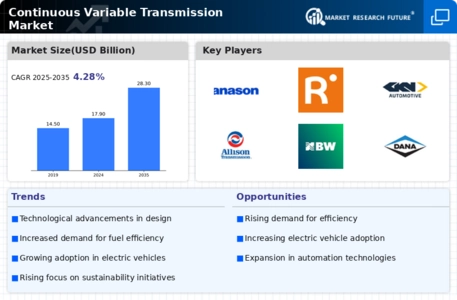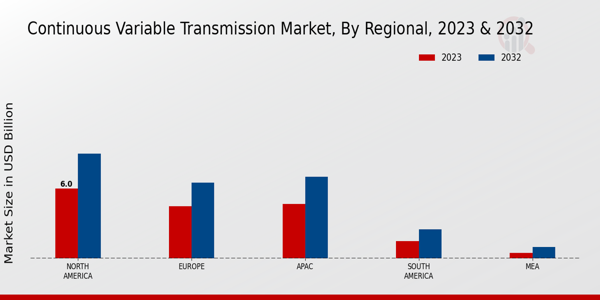Growing Electric Vehicle Adoption
The shift towards electric vehicles (EVs) is significantly influencing the Continuous Variable Transmission Market. As more consumers opt for EVs, the demand for efficient transmission systems that can optimize performance becomes paramount. Although many electric vehicles utilize single-speed transmissions, the integration of CVTs in hybrid models is gaining traction. This is due to their ability to provide smooth acceleration and improved energy management. The increasing focus on reducing carbon footprints and enhancing vehicle performance is likely to drive the adoption of CVTs in hybrid electric vehicles, thereby impacting the Continuous Variable Transmission Market positively.
Rising Demand for Fuel Efficiency
The Continuous Variable Transmission Market is experiencing a notable increase in demand for fuel-efficient vehicles. As consumers become more environmentally conscious, manufacturers are compelled to innovate and enhance fuel economy. Continuous variable transmissions (CVTs) offer superior fuel efficiency compared to traditional automatic transmissions, which is appealing to both consumers and manufacturers. In fact, vehicles equipped with CVTs can achieve fuel savings of up to 10-15% compared to their conventional counterparts. This trend is likely to drive the adoption of CVTs in various vehicle segments, including passenger cars and light trucks, thereby propelling the growth of the Continuous Variable Transmission Market.
Increased Investment in Automotive R&D
Investment in research and development within the automotive sector is a key driver for the Continuous Variable Transmission Market. As manufacturers seek to enhance vehicle performance and efficiency, R&D initiatives are focusing on developing advanced transmission technologies. This includes exploring new materials, improving design, and integrating smart technologies into CVTs. The automotive industry is projected to allocate a significant portion of its budget to R&D, which is likely to yield innovative solutions that enhance the functionality of CVTs. Such investments not only improve the competitive landscape but also contribute to the overall growth of the Continuous Variable Transmission Market.
Regulatory Support for Emission Reductions
Regulatory frameworks aimed at reducing vehicle emissions are becoming increasingly stringent, which is influencing the Continuous Variable Transmission Market. Governments worldwide are implementing policies that encourage the adoption of technologies that enhance fuel efficiency and reduce greenhouse gas emissions. CVTs, known for their ability to optimize engine performance and minimize fuel consumption, are well-positioned to meet these regulatory demands. As manufacturers strive to comply with these regulations, the demand for CVTs is expected to rise, thereby fostering growth in the Continuous Variable Transmission Market. This regulatory support is likely to create a favorable environment for CVT adoption across various vehicle segments.
Technological Innovations in Transmission Systems
Technological advancements play a crucial role in shaping the Continuous Variable Transmission Market. Innovations such as improved electronic control systems and advanced materials are enhancing the performance and reliability of CVTs. These developments not only improve the driving experience but also contribute to better fuel efficiency and lower emissions. For instance, the integration of hybrid technology with CVTs is becoming increasingly prevalent, allowing for seamless transitions between electric and gasoline power. This synergy is expected to attract more manufacturers to invest in CVT technology, thereby expanding the market. The continuous evolution of transmission systems indicates a promising future for the Continuous Variable Transmission Market.


















Leave a Comment